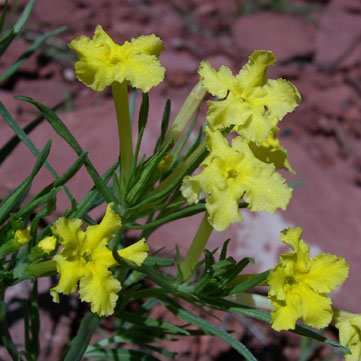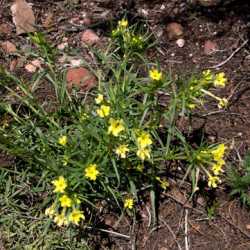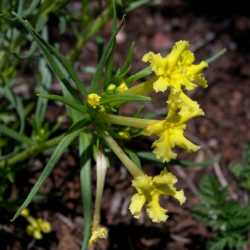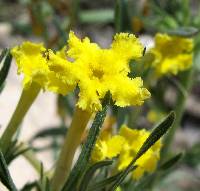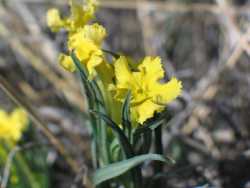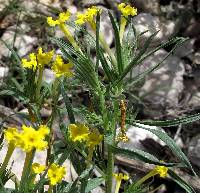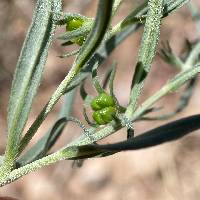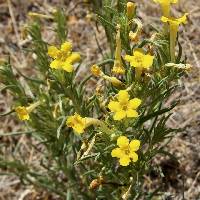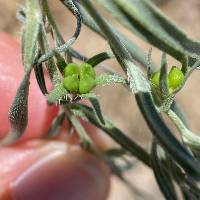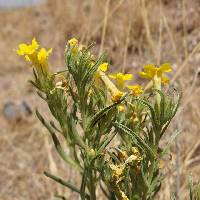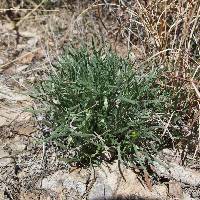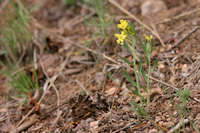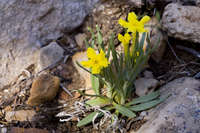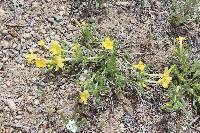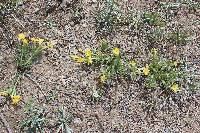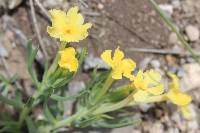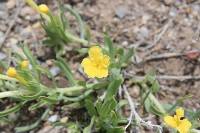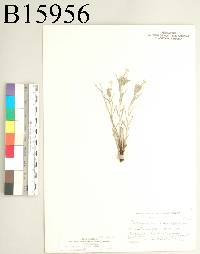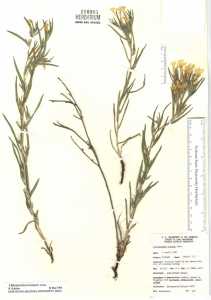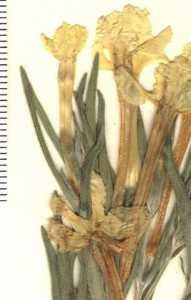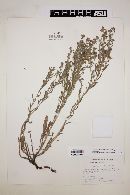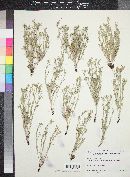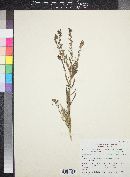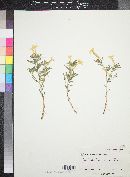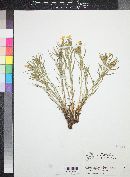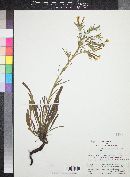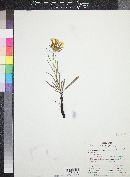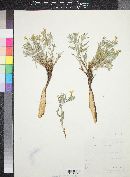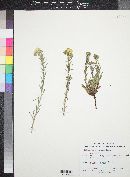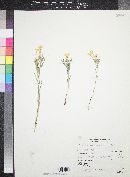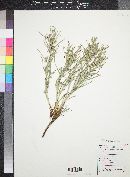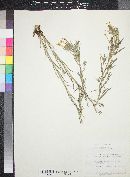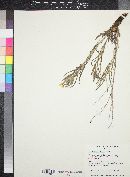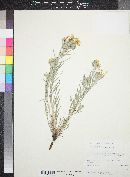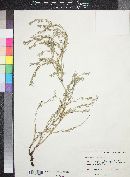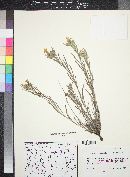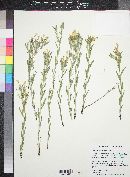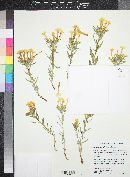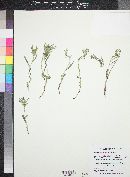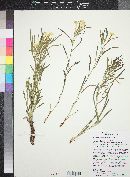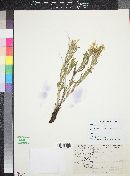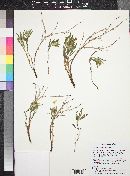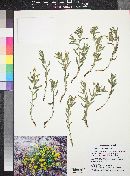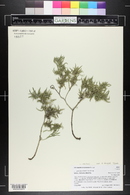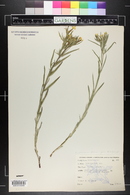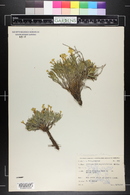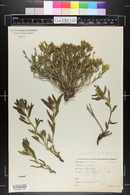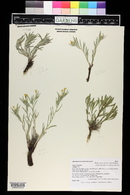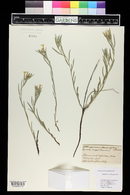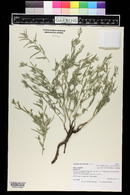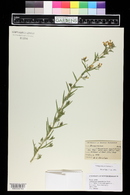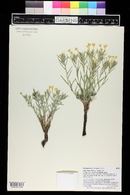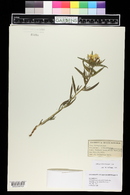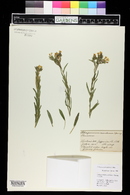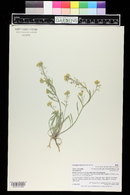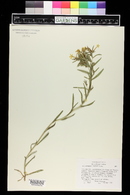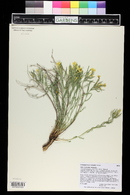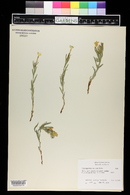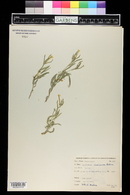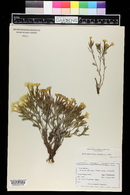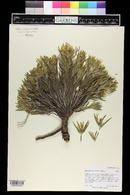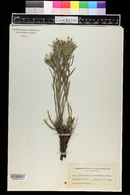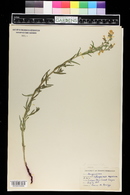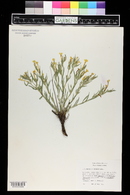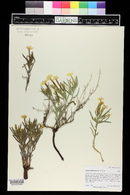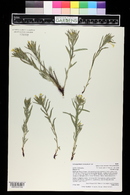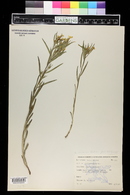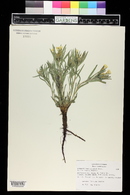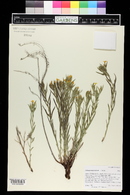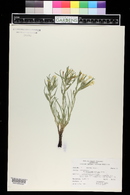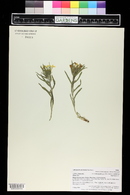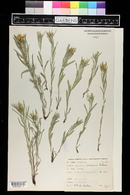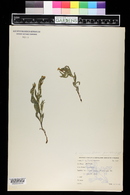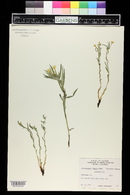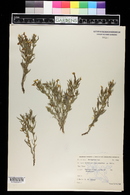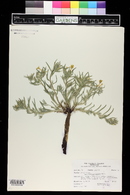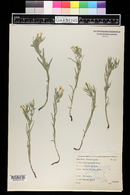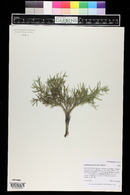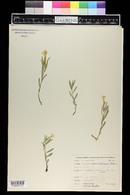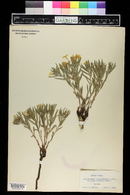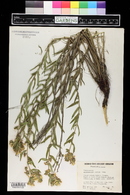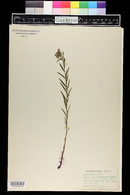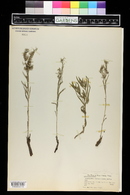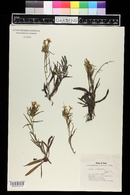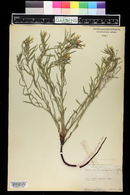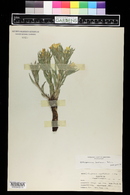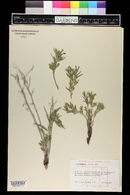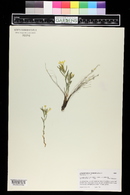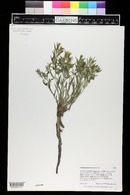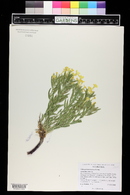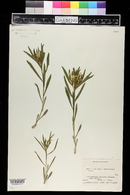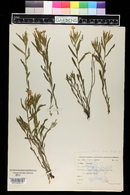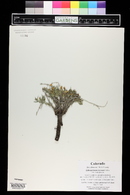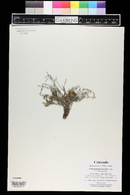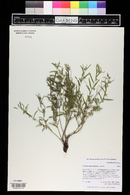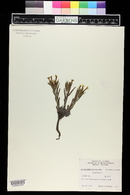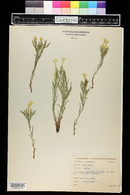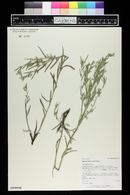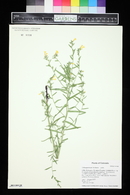Lithospermum incisum
|
|
|
|
Family: Boraginaceae
Fringed Gromwell, more...narrowleaf stoneseed, Fringed puccoon, narrowleaf gromwell, narrowleaf pucoon, trumpet stoneseed
[Batschia linearifolia (Goldie) Small, moreBatschia longiflora Pursh, Lithospermum angustifolium Michx., Lithospermum linearifolium Goldie, Lithospermum mandanense Spreng.] |
Perennial herb 5 - 50 cm tall Stem: erect, arising from a woody taproot, soft-hairy with appressed straight hairs, becoming more slender and more branched above as lower flowers start to develop. Leaves: numerous, alternate, stalkless, non-toothed, firm, without obvious lateral veins, 2 - 6 cm long, 2 - 6 mm wide, much longer than wide, linear or narrowly lance-shaped, and covered with soft appressed hairs. The lowest leaves are often reduced in size, and there are no basal leaves. Inflorescence: of early-developing, short-stalked, large, showy, bright yellow flowers crowded in axils of upper leaves terminating stem; and later-developing, smaller, non-opening (cleistogamous) flowers in leaf axils further down stem. The larger, showy flowers in the upper leaf axils are mostly sterile, while the smaller cleistogamous flowers below are very fertile, and the plant becomes more elongate and branched as these fertile, but closed flowers develop. Flowers: of two kinds: early-developing, showy, but mostly sterile, bright yellow, 1 - 2 cm broad, funnel-shaped (long narrow tube and large spreading lobes) with long styles; and later-developing, highly fertile, smaller, non-opening (cleistogamous), tubular, without obvious lobes, but with short styles. Sepals: five, much shorter than petal tube, narrow, much longer than wide, narrowly lance-shaped with slender pointed tips, and covered with soft, appressed hairs. Petals: five, but fused for well over half their length (in showy, sterile flowers) or almost all their length (in smaller, non-opening fertile flowers). The showy but mostly sterile flowers have a 1.5 - 4 cm long narrow tube, which separates into five, spreading, somewhat oblong to narrowly rounded lobes with broad rounded tips, and irregularly toothed or jagged edges. Cleistogamous flowers with small, not obvious, or no lobes at tip of tube. Stamens: five, attached inside near top of petal tube, but the oblong anthers not extending past the petal tube. Pistil: with one, deeply four-lobed, superior ovary; one, slender style; and one, distinctly two-lobed stigma. The styles of each flower type are of two different lengths in relation to the stamens (heterostyly): the showy, sterile flowers have long styles; and the non-opening, fertile flowers have short styles; but neither type extends past the petal tube. Fruit: a cluster of one to four, erect, shiny, ivory-white, hard, bony, sparsely pitted, about 4 mm tall, egg-shaped nutlets with narrowed, somewhat pointed tips, and a rounded base with a central, constricted, collar-like rim. The nutlet clusters are subtended by the spreading persistent sepals, and held on mostly recurved stalks. Similar species: Lithospermum incisum is most similar to L. canescens and L. caroliniense, but both of those species typically have spreading hairs on the stems, the leaves are wider (over 4 mm), the petal tubes are shorter (under 1.5 cm), the petal lobes are non-toothed, and the nutlets are smooth and non-pitted. Our other three species of Lithospermum have much smaller and less showy flowers with the sepals usually as long or almost as long as the petal tube, and the sepals mostly remain erect around the fruit. In addition two of those three species have leaves with very obvious lateral veins. Flowering: May to June Habitat and ecology: Occasional, but localized to dry prairies, or hill prairies in the more northwest area of the Chicago Region. Occurence in the Chicago region: native Notes: Lithospermum incisum is more common westward, in dry plains and barrens. It is a bit curious that the showy flowers of this species rarely produce fertile fruit. However, the more tubular, inconspicuous, smaller, cleistogamous flowers which are self-fertilizing produce much fertile fruit. This would seem to indicate that the species is much more successful at self-pollination than cross-pollination or out-crossing. Author: The Field Museum Martin and Hutchins 1980, Kearney and Peebles 1969, Kelley et al 2016 (Jepson Manual Online) Duration: Perennial Nativity: Native Lifeform: Forb/Herb General: Perennial herb, 10-40 cm tall, from a woody caudex and taproot charged with red dye; stems erect or ascending, often clustered; herbage strigose. Leaves: Alternate and sessile; blades linear to linear-oblong, 1-6 cm long. Flowers: Yellow, in terminal, leafy-bracted racemes; calyx 6-10 mm long, with 5 linear lobes; corolla bright yellow, salverform, the tube 1.5-3.5 cm long, at least twice as long as calyx, the lobes fimbriate (ruffled) or toothed, the crests conspicuous and arched; later flowers are self-fertilizing (cleistogamous), with a smaller corolla. Fruits: Pedicels becoming reflexed in fruit; nutlets 2-3 mm long, ovoid with an acute tip, pitted on the surface, gray-white and shiny. Ecology: Found on open slopes and flats, from 4,000-7,500 ft (1219-2286 m); flowers April-June. Distribution: Most of w N. Amer. from CAN south to CA, east to LA; also in FL; south to c MEX. Notes: A showy perennial when in flower; distinguished by having many semi-weak branches; stiff, appressed hairs all over; dark green to gray-green, linear leaves with the mid-veins whitish and obvious; showy, yellow, trumpet-shaped flowers with elongate tubes and incised or ruffled lobes; and smooth, tear-drop shaped rock-hard nutlets. Distinguished from L. cobrense by its long, narrow flowers that are glabrous inside the corolla tubes (L. cobrense has short, wide corollas that are villous inside); distinguished from L. multiflora by the length of the corolla, 1.5-3.5 cm, and leafy lower stems (L. multiflora has smaller flowers, with corollas about 1 cm long, and lacks leaves on the lowest inch or two of the stems). Ethnobotany: Many medicinal uses including as an orthopedic aid for paralysis, an oral contraceptive, a psychological aid, an eye medicine, a sedative and a stimulant; also used to treat hemorrhages, colds, coughs, sore throats, stomachaches, and skin infections. Culinary uses included making a tea and boiling and eating the roots. Also used ceremonially and to make blue or purple dye. Etymology: Lithospermum is from the Greek lithos, stone, and sperma, seed; incisum means deeply or irregularly cut or cleft, referring to the corolla margins. Synonyms: Batschia linearifolia, Lithospermum angustifolium, L. linearifolium, L. mandanense Editor: SBuckley 2010, FSCoburn 2015, AHazelton 2016 Strigose perennial from a woody taproot, 0.5-4 dm; lvs wholly cauline, the lowest often reduced, the others linear-oblong to narrowly lanceolate or linear, rather numerous, 2-6 cm נ2-6 mm; well developed fls crowded in the uppermost axils, short-pedicellate; cor bright yellow, salverform, the tube 1.5-3.5(-4) cm, the limb 1-1.5(-2) cm wide, with erose or almost fimbriate lobes, these fls long-styled and mostly sterile; cleistogamous, highly fertile, short-styled fls commonly developed later farther down the stem, the plant becoming slenderly much-branched; nutlets ivory-white, shining, sparsely pitted; 2n=24, 36. Dry plains and barrens; s. Ont. to Man. and Wis., w. to B.C., Utah, s. Nev., and n. Mex. Apr., May. (L. angustifolium; L. linearifolium) Gleason, Henry A. & Cronquist, Arthur J. 1991. Manual of vascular plants of northeastern United States and adjacent Canada. lxxv + 910 pp. ©The New York Botanical Garden. All rights reserved. Used by permission. From Flora of Indiana (1940) by Charles C. Deam This rare species has been reported from only Putnam, Steuben, Tippecanoe, and Vigo Counties. Grimes' specimens from Putnam and Tippecanoe Counties are in the herbarium of DePauw University. Found in sandy and gravelly open places. Infrequent along the roadside southwest of Lafayette, on the gravelly terrace of Big Wea Creek west of the Wabash Railroad. .…… Indiana Coefficient of Conservatism: C =10 Wetland Indicator Status: N/A |
|
|
|

